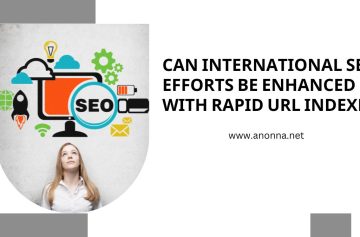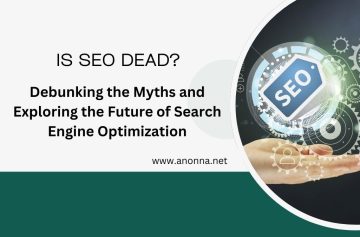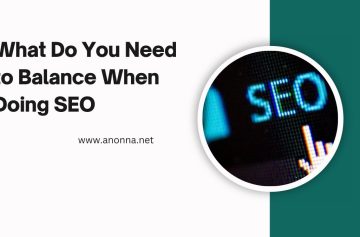
What Is ADHD in SEO? Understanding Attention Deficit in Digital Marketing and SEO Strategies
Why Am I Telling You What Is ADHD in SEO ? Attention Deficit Hyperactivity Disorder (ADHD) is a disorder defined by problems with sustaining attention, a tendency towards impulsive action, and hyperactivity. ADHD is often thought of in terms of medical diagnoses, but may also be relevant in a metaphorical sense to SEO (Search Engine Optimization) and digital marketing. Constant distractions, chasing trends, and ever-changing strategies make this an especially challenging landscape for SEO professionals and marketers, which can lead to inefficient workflows and inconsistent results.
The Effects of Distraction and Lack of Focus on SEO Professionals
You may only build SEO till Oct 2023. But in the ever-evolving landscape of digital marketing, a common phrase among SEO professionals is “SEO ADHD”—the tendency to jump from one digital marketing avenue to another without truly executing or assessing effectiveness.
Common Distractions Seen in the World of SEO:
✅ Never taking the time to master the basics of SEO, always running after the latest Google algorithm update.
✅ Alternating between different SEO tools and techniques and expecting immediate success.
✅ Depriving oneself to learn about SEO and not using a step-by-step process.
✅ Introducing new tactics on a whim, without testing or measuring their impact.
This Dilution of Focus Can Result In:
❌ Patchy SEO results—if your strategy changes, search engines may get confused.
❌ No proper keyword + content strategy – without specific targets, solutions are scattered everywhere.
⛔️ Loss of time and energy — Doing too many things at the same time lowers your throughput.
Purpose of This Article
In this article, we will discuss the ADHD-like tendencies in SEO, how they are detrimental to our SEO success, and some actionable strategies on how to keep focus and be productive in SEO. Understand these patterns in your behavior, employ disciplined SEO strategies, and you’ll see sustained growth, higher rankings, and endurance in digital marketing.
Understanding ADHD in SEO
SEO demands patience, strategy, and analysis. The habits that most digital marketers and SEO professionals fall into, generally seem to produce distraction, impulse changes, and lack of consistency which are akin to ADHD-like behavior in SEO. It creates poor efficiencies, results in low ranking presumably, and ultimately in wasted efforts.
What is ADHD from an SEO Perspective?
ADHD stands for Attention Deficit Hyperactivity Disorder, and of course, it is a medical condition, but we can also chat about what we might call an SEO version of this — the SEO ADHD. Data disruptions in SEO come in these forms:
✅ Trying out the latest Google algorithm update without fully optimizing existing strategies
✅ Flitting between different SEO strategies without a step-by-step approach.
✅ Consuming too much information on SEO and taking no action.
✅ These folks focus on short-term SEO tricks instead of building for long-term sustainable growth.
These actions are the effect of the information overload, and shiny object syndrome (the urge to hop on new tools, trends in real-time without a well-defined scope of the relationship and analysis).
3 Key Areas Where SEO Execution is Impacted by Information Overload and Shiny Object Syndrome
1️⃣ The New (and Shiny) Strategies Spoil the Soup
SEO specialists are often bombarded with posts, courses, and social media tips & tricks, which ends up shifting focus.
2️⃣ Shiny Object Syndrome Hinders Execution Efficiency
A lot of marketers jump at new SEO fads (think AI-generated content, schema markup, zero-click searches) and abandon their existing strategies too soon before getting the results.
3️⃣ Frequent Changes Create Confusion for Search Engines
Google’s algorithms appreciate consistency, so using different tactics too frequently will not allow websites to build authority and trust.
No doubt SEO success takes months of test, learn, and adapt – not knee-jerk revisions to keep pace with the latest SEO fad.
Typical Symptoms of ADHD in SEO and Digital Marketing Professionals
Soon, we will be exploring ADHD in prospects and how that is affecting marketers — if you or your team are having issues focusing on SEO, you may have ADHD in terms of digital marketing. Here are some key signs:
Change Your SEO Strategy Without Evaluating Instead of Coping
❌ Rapid fire switching on the on-page optimization, link-building strategies, or content styles without giving it time to produce results.
❌ Starting a new keyword strategy every couple of weeks rather than tracking and refining what you already have.
❌ Making frequent changes to the site structure, URLs, or metadata, where such changes can have a negative effect on long-term rankings.
✅ Problem: Not giving strategies enough time to work and adapting too quickly to SEO roadmaps based on data (up to October 2023).
Too Many SEO Trends at Once Without Getting the Basics Down
Finding yourself (not so surprisingly) struggling to implement AI-driven SEO, voice search optimization, and core web vitals improvements all simultaneously (without truly understanding the nuances of any of them).
❌ Conducting a lot of SEO experiments at the same time without proper monitoring.
❌ Investing your time in the latest SEO trends instead of optimizing existing content.
✅ Solution: Focus on one or two SEO hand-picked trends before making up with trend challenges, ensure execution quality first before going to the next trend.
Having Difficulties with Sustainable Consistency in Content and Technical SEO
❌ Publishing blog posts sporadically without a content calendar.
❌ Surrendering long-term technical SEO efforts (e.g. site speed improvements, structured data implementation) because the results do not materialize overnight.
❌ Neglecting to perform regular audits for SEO, build backlinks, or track keywords.
✅ Solution: An SEO workflow with scheduled tasks, where repetitive processes are automated to create sustainable operations and long-term benchmarks are set.
Key Takeaway
You need to consistently put in resources and perform actions focused towards this aim. Just like ADHD, if you were able to realize some of the ADHD-ish behaviors exhibited in some SEOs, you could cut down distractions, take better action, and get proper rankings that last.
ADHD in SEO Strategy and Performance
As we evolve in the field of SEO, we find ourselves needing to adapt everything frequently, and toggling new strategies without even boosting the current strategies is a bit detrimental for the site’s performance. A common problem among SEOs is the tendency to chase shiny objects, make tactical changes without tracking changes over time, and generally jumping haphazardly from one initiative to another — resulting in variable results.
The Detriments of Lack of Focus on SEO Results
SEO is long-term and you need patience, consistency, and structured implementation. But one of the biggest mistakes that many digital marketers make is trying constantly to change up their SEO approach without allowing enough time for it to yield results.
How Constant Change and Disconnected Efforts Can Erode SEO Performance
📌 Content does not get indexed, analyzed, and ranked instantaneously by search engines like Google. This is especially true if you change keywords, URLs, content structures, or backlink strategies often:
❌ Before that, Google may have issues understanding the authority and relevance of your site.
❌ Algorithm confusion could tank pages that were moving up.
✅ Solution: Change only what is necessary, begin monitoring the impact, and give Google time to make adjustments before second changes are made.
By maintaining focus and structured execution, SEO professionals can avoid the pitfalls of ADHD-like behaviors and achieve consistent, long-term success.
The Importance of Consistency in SEO Results
SEO is not an instant win — it’s a long-term growth machine. Search engines prefer websites that keep content of quality, backlinks of authority, and a reliable user experience over time.
And here’s how consistency is SO important in achieving SEO success:
Long-Term SEO Strategies Over Short-Term Remediation
A lot of SEO pros lust for instant ranking hacks—keyword pilfering, link-eating, or flicker content trends. These tactics do not work in the long run, however.
Problems with Short-Term Tactics:
- Manipulative techniques trigger detection and penalty by Google algorithms.
- Short-term tactics fail to build any credibility or lasting visibility.
- Changing your strategy all the time confuses search engines and users.
Solution:
- Develop a long-term plan with a milestone-driven approach instead of forceful tactics.
- Use sustainable SEO strategies that comply with Google’s best practices.
- Prioritize SEO enhancements quarterly, not daily or weekly tweaks that you don’t need.
On Consistency and Authority — How Google’s Algorithms Reward Them
Google’s ranking system favors authority, expertise, and relevance. Websites that publish high-quality content regularly and maintain strong backlinks usually experience stable ranking growth.
Benefits of SEO Consistency:
- Greater domain authority — Google trusts sites that give ongoing value through time.
- Consistent ranking performance — Regularly optimized content has a higher chance of being ranked in the long run.
- Better audience engagement — Frequent updates make readers come back and engage with the content.
Solution:
- Continue to update your content consistently and build backlinks regularly.
- Pursue an SEO strategy that maintains steadiness with continual enhancements.
- Focus on proactive optimizations rather than tweaking random algorithm responses.
Avoiding Complexity Creep by Structuring Your Focus
A content plan or strategy helps you avoid random changes in focus and keeps your site moving.
Examples of Structured SEO Content:
- An editorial calendar that describes what will be published and when.
- Relevant pillar content and mapped topic clusters to search intent.
- Lighter internal link structures for new content to share SEO equity with older content.
Solution:
- Create a thematic content roadmap for each quarter.
- Complete content clusters before switching to new SEO ideas.
- Use content labeling to group beginner, intermediate, and advanced content into silos while keeping a bridge between them.
Last Words: SEO Results Never Come Overnight; It Requires Patience and Discipline
- Without focus, SEO results are inconsistent, efforts are wasted, and opportunities are missed.
- To achieve scalable success in SEO, think long-term, build authority, and create valuable content.
- Consistency aligns with Google’s expectations—frequent and impulsive changes can undermine ranking gains.
Here’s How You Can Combat ADHD Tendencies in SEO
Long-term SEO success relies on focus, consistency, and data-driven decision-making. If you feel like you’re haphazardly trying all strategies, hopping from one trend to the next, and failing to capture your impact, it’s time to be systematic.
SEO Strategy: Building with Focus and Sustainability
The top performers in search engine optimization create a structured plan with measurable goals to avoid chasing the next new thing in the industry.
Establishing Clear SEO Objectives with Specific KPIs
Why It Matters:
- Ensures that SEO efforts align with business goals.
- Well-articulated KPIs allow measuring what works and what doesn’t.
- Prevents random strategy shifts that lead to inconsistent results.
Best Ways to Focus Your SEO Goals:
- Set tangible and realistic SEO goals (e.g., “Grow organic traffic by 20% in 6 months”).
- Select key performance indicators (KPIs), such as:
- Organic traffic growth
- Click-through rates (CTR)
- Domain authority improvements
- Organic search conversion rates
- Focus on 1-2 target areas at a time rather than tackling too many goals simultaneously.
Focus on One or Two Tactics at a Time
Why It Matters:
- Specializing in one or two main SEO tactics allows for better execution.
- Prevents jumping between too many strategies aimlessly.
- Enhances metric tracking and performance measurement.
Examples of Laser-Focused SEO Techniques:
- SEO Audit: Content-level SEO strategy, keyword targeting, and blog optimizations.
- Technical SEO Strategy: Website speed optimization, core web vitals improvements, and fixing crawler errors.
- Link Building Strategy: Guest posting, digital PR, and acquiring quality backlinks.
Best Practice:
- Choose one main strategy to work on each quarter, assess performance, adapt, or expand based on results.
SEO Project Management Tools to Keep You on Track
Why It Matters:
- Helps organize SEO tasks, timelines, and team collaboration.
- Maintains a clear process, preventing impulsive changes.
- Provides transparency into current and past SEO projects.
Best Tools for SEO Project Management:
- Trello – For content planning and SEO task tracking.
- Notion – Organizing SEO workflows, SOPs, and team collaboration.
- ClickUp – To organize SEO campaigns and monitor progress.
Best Practice:
- Use these tools to implement deadlines, monitor SEO changes, and review metrics regularly.
How Not to Be a Paint-On Dashboard: Avoiding Shiny Object Syndrome in SEO
Many SEO tactics follow the latest trends or algorithm updates without evaluating their long-term impact. This often leads to constant strategy shifts and wasted effort.
Identifying What SEO Trends Are Worth Following
Why It Matters:
- Not all SEO trends have a lasting impact on rankings.
- Some trends gain popularity but lack long-term benefits for SEO.
- Testing trends before implementation saves time and resources.
How to Assess an SEO Trend:
- Ask: Will this trend affect rankings or user experience in a visible and measurable way?
- Research how Google has reacted to similar past trends.
- Analyze SEO case studies for long-term results.
- Run small tests before implementing site-wide changes.
Example:
- Important Site Improvement: Google’s emphasis on Core Web Vitals influencing page ranking processes.
- Distraction: An AI-based SEO tool that promises instant #1 ranking without proof.
Test First Before Making Broad SEO Changes
Why It Matters:
- Helps avoid major SEO mistakes that could negatively impact rankings.
- Allows data collection before making large-scale changes.
- Ensures SEO efforts are based on proven performance rather than speculation.
Steps to Test an SEO Strategy:
- Changes to A/B Test: Do not make changes to all pages at once; select a test group.
- Track Performance: Use Google Search Console to monitor impressions, CTR, and ranking shifts.
- Assess Backlink and Traffic Growth: Before scaling outreach or link-building efforts.
Example:
- Test a UX change on a landing page before applying it site-wide.
Setting Data-Driven Goals Rather Than Acting on Impulse
Why It Matters:
- SEO decisions should be guided by performance metrics, not gut feelings.
- Ensures optimizations are based on analytics and historical data.
- Prevents unnecessary strategy pivots due to temporary ranking fluctuations.
Best Practices for Data-Driven SEO Decisions:
- Monitor organic performance through Google Analytics & Google Search Console.
- Identify which SEO strategies have historically paid off.
- Benchmark SEO experiment results before making significant changes.
Example:
Instead of assuming “blog posts with videos rank better,” analyze engagement data before making video content mandatory.
Final Key Point: SEO = Longevity
Build an SEO strategy with clear goals and priorities.
Do not follow all SEO trends, stick to tested sustainable things.
Track your SEO progress with data, testing, and project management tools.
SEO Best Practices to Stay Focused
Keeping your focus in SEO is essential if you want sustainable rankings, increased traffic, and long-term success. Displacement, ongoing downtime, lack of focus and no strategy are some of the reasons that create hurdles for SEO professionals, leading to unwarranted efforts.
In this section, the best practices for keeping your focus in SEO are discussed with scattered workflows, automation and accountability measures so that you keep marching ahead without getting cluttered with unnecessary things.
Creating an SEO Workflow That Minimizes Interruptions
Keyword research, content optimization, link building, technical audits — SEO happens on many fronts. Without a system in place to guide this workflow, it is all too easy to get distracted from your fluency practice—jumping between tasks and losing productive time.
Here is how to create an SEO process that works like magic while allowing for fewer distractions.
How to Structure Daily and Weekly Tasks in SEO
Why it matters:
- Structured guide for day-to-day and week-on-week SEO tasks.
- Helps keep us from making big decisions impulsively by establishing task priorities.
- Will keep all parts of SEO covered—content, technical, link building, tracking, etc.
SEO Workflow Schedule Example:
Daily SEO Tasks:
- Use Google Search Console to see if there are indexing errors or falling rank.
- Tracking important SEO KPIs (organic traffic, CTR, keyword rankings).
- Answer any SEO-related questions, comments, or link-building opportunities.
Weekly SEO Tasks:
- Perform on-page optimizations (content changes, metadata updates, internal linking).
- Audit technical SEO health (site speed, dead links, mobile availability).
- Explore competitors’ SEO to gain insights and identify new opportunities.
Monthly SEO Tasks:
- Know all SEO standards, perform detailed SEO audits to find ways to grow.
- A way to improve outdated content and keep it fresh and ranking.
- Create new content based on keyword trends and shifts in search intent.
Best Practice:
Book your SEO time with Google Calendar, Notion or Trello and track the progress.
Repeating Processes for SEO and How to Automate Them with Checklists
Why it matters:
- Conducts repetitive SEO tasks automatically, saves time.
- Ensures consistent and accurate execution of SEO.
- Its structured nature eliminates mental clutter.
SEO Checklists for Work Efficiency:
Keywords:
- Make sure the target keyword is used in the H1 and H2 tags.
- Use the proper meta tags like Title, Description, Meta Keywords, and Robots tag.
- Check if the content is focused.
- Clear and skimmable content: Use Headings properly, Include bullet points and keep paragraphs short.
Technical SEO Checklist:
- Indexing status, site speed, structured data validation.
- Outreach/influencer tracking, backlink analysis, anchor text optimization.
Automation Tools to Use:
- Google Search Console & Screaming Frog — Site audits with automated error detection.
- SEMrush & Ahrefs – Automated rank tracking and backlink monitoring.
- Zapier & Notion – Take SEO task management and alerts to another level!
Best Practice:
Wherever possible, automate tasks, but make sure there is a human involved in important decisions.
For High-Importance SEO Tasks, Scheduling Deep Work Sessions
Why it matters:
- Avoids multitasking and constant distractions that make less productive.
- Enables SEO practitioners to concentrate on complex, high-value tasks.
- Better strategic thinking and SEO execution.
Deep Work for SEO: How to Do It
- Eliminate context switching by scheduling all deep work required for high-impact SEO efforts (ex: 90 minutes of focused work).
- Minimize distractions: disable notifications, close tabs, and use focus timers.
Focus on Long Term Work:
- Creating pillar content and optimizing for E-E-A-T (Experience, Expertise, Authoritativeness, Trustworthiness).
- Implementing advanced technical SEO fixes (architecture improvements, Core Web Vitals).
- Leveraging data to create long-tail SEO strategies.
Best Practice:
Deep work: For focused work, use tools like Pomodoro timers or website blockers.
Monitoring Progress and Maintaining Accountability
SEO is about data and tracking progress makes sure the strategy is working. But if tracking is done poorly, SEO professionals will end up making decisions based on assumptions rather than data about real performance.
Here’s how to keep yourself accountable for SEO progress and keep that progress coming.
Why Regular SEO Audit And Performance Tracking Is Important
Why it matters:
- How you identify what’s working and what needs to improve.
- Avoids hasty changes in strategy on the basis of short-term trends.
- Data that can guide your SEO strategy so it aligns with your business goals and the direction of the search engines.
Must-Track SEO Metrics:
- Organic Traffic – Keep an eye on performance for visitors from search to your site.
- Keyword Rankings — Monitor keyword ranks and competitive data.
- Click-Through Rate (CTR) – Find out if meta descriptions and title tags are persuasive.
- Bounce Rate & Time on Page — Monitor the relevance of your content and users engagement.
- Backlink Profile Growth – Monitor domain authority and quality of the links acquired.
Best Practice:
Use Google Analytics, Ahrefs, or SEMrush to do monthly SEO audits to track long-term trends and optimize accordingly.
How Follow Through Is Essential — Repeating, Reporting & Updating Strategies Based on Data
Why it matters:
- Prevents random tweaks, driven by short-term ranking dance.
- Landing on the single best answer helps SEO ideas stay aligned long term.
- Leverages historical SEO data for decision-making rather than relying on intuition.
Good SEO Reporting Practices:
- Build weekly or monthly SEO reports to show your progress and key learnings.
- Visualize performance trends with Google Looker Studio (Data Studio).
- Track SEO growth over time by comparing previous performance periods.
Best Practice:
Think of SEO like a science experiment—test, measure and optimize your strategies based on what the data is telling you, not your feelings or assumptions.
SEO Team Collaboration — How to Keep Your Teams Accountable
Why it matters:
- Having an SEO accountability partner (or team) takes the guesswork out of strategy decisions.
- Prevents reckless SEO changes as you need to discuss whether the opportunity that the new tactic provides is worthy enough to chase.
- Provides peer review and feedback, which can enhance SEO decision-making.
How to Keep Teams Accountable:
- Routine meetings on managing search engine optimization.
- Divide and conquer (e.g., one person handles content SEO, another technical SEO).
- Share dashboards and SEO reports so everyone is aligned.
- Measure success by setting quarterly SEO goals and reviewing them as a team.
Best Practice:
If you work alone, consider joining SEO communities or even mastermind groups for accountability and to stay on top of industry changes.
Conclusion
SEO professionals can stay consistent and achieve sustainable success by setting clear goals, prioritizing key strategies, leveraging automation, and tracking progress using data-driven insights.








Add comment